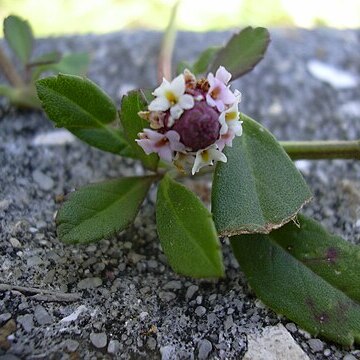Perennial herbs, procumbent or creeping; tomentum of medifixed hairs. Stem trailing or ascending, often rooting at nodes. Leaves simple, decussate, petiolate or subsessile. Inflorescence spicate, axillary, pedunculate. Flowers bracteate, sessile, zygomorphic; bracts imbricate. Calyx persistent, membranous, ovoid to campanulate or compressed, with 2 keels or wings and 2-lobed; rim 2-or 4-fid or 4-dentate. Corolla hypocrateriform; tube cylindrical or slightly dilated upwards; lobes obliquely subbilabiate, 4–5-fid, upper lip entire to 2-lobed, lower lip 3-fid. Stamens 4, didynamous, epipetalous, included or scarcely exserted; anthers nonappendiculate. Ovary 2-locular, with 1 ovule in each locule; style short; stigma oblique, thick. Fruit schizocarpic, splitting into two 1-seeded mericarps. Seeds without endosperm.
Fls in dense, elongating, pedunculate axillary spikes; bracts small, cuneate-obovate to flabelliform; cal small, membranous, often compressed or even winged, with 2 or 4 teeth or segments; cor-tube very slender, straight or incurved, slightly exserted from the cal, the limb oblique, spreading, 4-parted and somewhat 2-lipped; stamens 4, paired, included or slightly exserted; anthers unappendaged; ovary with 2 uniovulate chambers; stigma thickened, oblique or recurved; fr included in the cal or even adnate to it, dividing into 2 nutlets, sometimes with separating thin exocarp; prostrate or creeping perennials with ± ascending or trailing branches, ± canescent with malpighian hairs. 10, originally N. Amer.
Trailing perennial herbs with angular stems rooting at the nodes. Leaves opposite, simple, subentire to toothed, mostly tapering into an obscure petiole; lamina with sparse to dense adpressed medifixed hairs. Inflorescences ± long-pedunculate axillary short ovoid to cylindric very dense bracteate spikes. Calyx membranous, 2-lobed, compressed. Corolla with short tube and spreading somewhat irregularly 4-lobed white or purple limb. Stamens 4, included. Fruit of 2 nutlets enveloped by the persistent calyx.
Herbs. Branches usually acutely 4-angled, sometimes spiny, hirsute, glandular. Leaves opposite. Inflorescences terminal, spicate or capitate, elongated in fruit; bracts obovate. Flowers small. Calyx membranous, 2-lipped, 4-lobed. Corolla sometimes 2-lipped; lobes 5, spreading. Stamens 4, didynamous, inserted on distal part of corolla tube, included. Ovary 2-locular; ovule 1 per locule. Style short; stigma capitate. Capsules small, splitting into 2 1-seeded cocci.
Mat-forming, unarmed herbs with prostrate, creeping stems. Lvs opposite, toothed or lobed, with medifixed hairs. Infl. a dense, subglobose to cylindric, axillary spike; fls sessile, small, bracteate. Calyx 2-lobed, divided almost to base, ± accrescent. Corolla limb 4-lobed, with 2 unequal lips; tube > calyx, straight. Stamens 4, included, didynamous. Ovary 2-celled, each cell with 1 ovule. Style included. Fr. dry, separating into 2 nutlets.
Corolla usually white, becoming rose-coloured; tube straight or curved, cylindric or widening toward the apex; limb oblique, c. 2-lipped, with the (upper) adaxial lip entire, emarginate or 2-lobed, and the lower (abaxial) lip 3-lobed with the median lobe usually larger than the others.
Fruit a schizocarp, compressed oblong, separating at maturity into two 1-locular mericarps; mericarps with a dry hard pericarp, semi ovoid, flat on the commissural face, rounded and smooth on the dorsal face, glabrous.
Inflorescences axillary, pedunculate, spicate; spikes short, dense, ovoid becoming cylindric after anthesis, with bracts closely imbricate.
Prostrate perennial herbs with woody taproots; indumentum of sparse to closely spaced appressed medifixed hairs or plants glabrous.
Ovary 1-carpellate, carpel 2-locular, each locule 1-ovulate; style short, undivided; stigma thick, obliquely capitate.
Leaves opposite, simple, shortly petiolate or subsessile, serrate.
Stems trailing, rooting at the nodes; branches short, ascending.
Calyx membranous, dorsiventrally flattened, 2-lobed, persistent.
Flowers small, sessile, each solitary in the axil of a bract.
Stamens 4, included or somewhat exserted.

